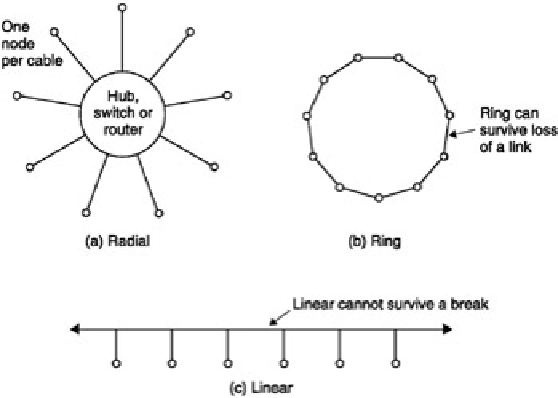Information Technology Reference
In-Depth Information
Ethernet uses distributed arbitration. FireWire is capable of using both types of arbitration. A small amount of
decision-making ability is built into every node so that distributed arbitration is possible. However, if one of the
nodes happens to be a computer, it can run a centralized arbitration algorithm.
The physical structure of a network is subject to some variation as Figure
7.22 shows. In radial networks, (a), each port has an unique cable connection to a device called a
hub
. The hub
must have one connection for every port and this limits the number of ports. However, a cable failure will only result
in the loss of one port. In a ring system (b) the nodes are connected like a daisy chain with each node acting as a
feedthrough. In this case the arbitration requirement must be distributed. With some protocols, a single cable break
doesn't stop the network operating. Depending on the protocol, simultaneous transactions may be possible
provided they don't require the same cable. For example, in a storage network a disk drive may be outputting data
to an editor whilst another drive is backing up data to a tape streamer. For the lowest cost, all nodes are physically
connected in parallel to the same cable.
Figure 7.22
(c) shows that a cable break would divide the network into two
halves, but it is possible that the impedance mismatch at the break could stop both halves working.
One of the concepts involved in arbitration is priority which is fundamental to providing an appropriate quality of
service. If two processes both want to use a network, the one with the highest priority would normally go first.
Figure 7.22:
Network configurations. At (a) the radial system uses one cable to each node. (b) Ring system uses
less cable than radial. (c) Linear system is simple but has no redundancy.
Attributing priority must be done carefully because some of the results are non-intuitive. For example, it may be
beneficial to give a high priority to a humble device which has a low data rate for the simple reason that if it is given
use of the network it won't need it for long. In a television environment transactions concerned with on-air
processes would have priority over file transfers concerning production and editing.
When a device gains access to the network to perform a transaction, generally no other transaction can take place
until it has finished. Consequently it is important to limit the amount of time that a given port can stay on the bus. In
this way when the time limit expires, a further arbitration must take place. The result is that the network resource
rotates between transactions rather than one transfer hogging the resource and shutting everyone else out. It
follows from the presence of a time (or data quantity) limit that ports must have the means to break large files up
into frames or cells and reassemble them on reception. This process is sometimes called
adaptation
. If the data to
be sent originally exist at a fixed bit rate, some buffering will be needed so that the data can be time- compressed
into the available frames. Each frame must be contiguously numbered and the system must transmit a file size or
word count so that the receiving node knows when it has received every frame in the file.

